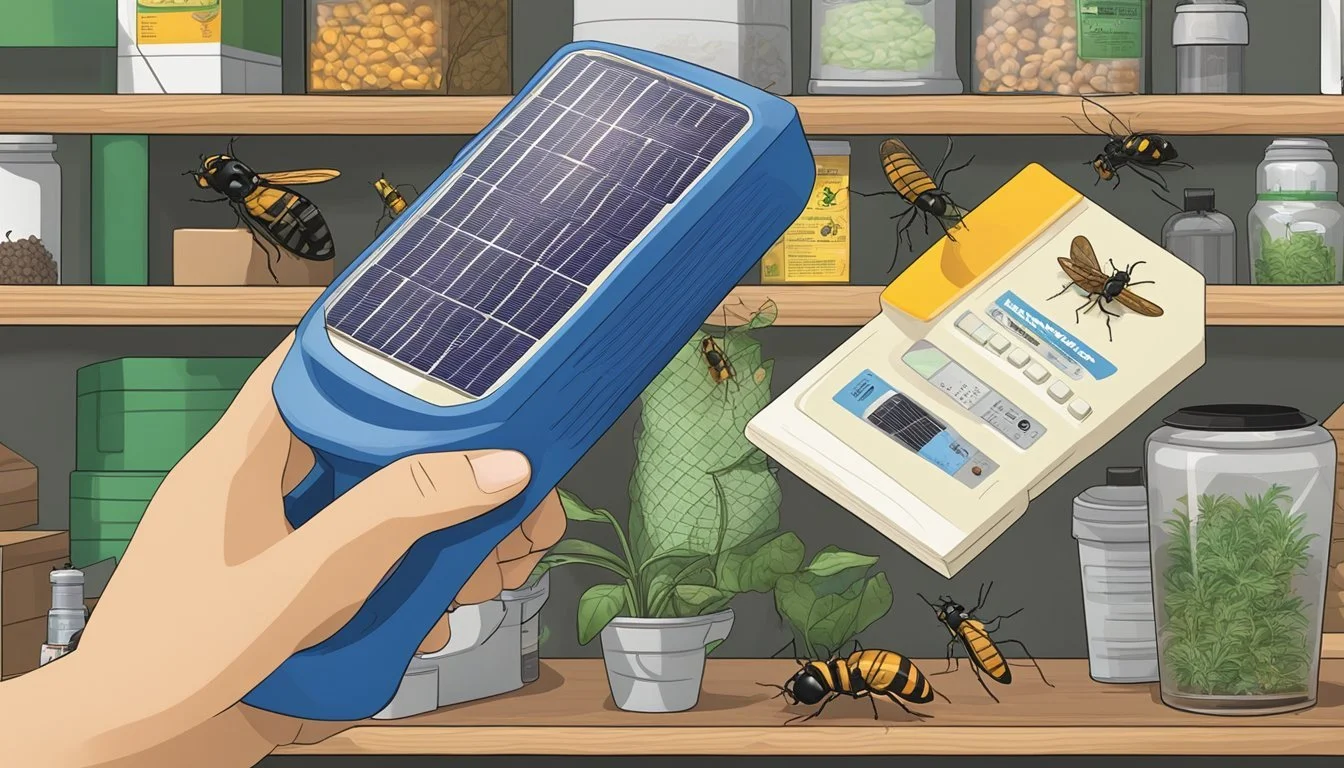Ultimate Guide to Using a Solar-Powered Bug Zapper
Effective Natural Pest Control Strategies for Homesteaders
In the pursuit of a more eco-friendly and sustainable homestead, solar-powered bug zappers have emerged as a powerful tool in the natural pest control arsenal. These devices harness the energy of the sun, converting it to electrical power to effectively lure and eliminate flying insects. For homesteaders, this method of pest control offers a low-maintenance and environmentally responsible alternative to traditional chemical repellents, ensuring their land remains free from the harmful effects of pesticides, while reducing their carbon footprint.
Solar-powered bug zappers are designed for ease of use, often requiring minimal setup and offering the flexibility to be placed in a variety of outdoor spaces. With their ability to operate without the need for an external power source, these zappers can function in remote locations, providing continuous protection against pests like mosquitoes, flies, and moths. As they offer the dual benefits of operating costs savings and adaptability, solar zappers suit the homesteader's lifestyle, which prizes self-sufficiency and ecological balance.
Understanding Solar-Powered Bug Zappers
Solar-powered bug zappers provide a renewable and eco-friendly solution to pest control. They use sunlight to generate electricity, then employ this power to eliminate insects with UV attraction and electric grids.
How Solar Bug Zappers Work
Solar bug zappers harness solar energy to charge built-in batteries during the day via solar panels. As dusk falls, these devices switch on, emitting UV light to attract insects. The bugs, drawn to the light, touch the charged electric grid within the zapper and are eliminated.
Benefits of Using a Solar Bug Zapper
Environmentally friendly: Solar bug zappers offer an eco-friendly alternative to chemical insect repellents. By relying on renewable solar energy, they reduce the carbon footprint associated with pest control.
Cost-effective: After the initial investment, solar bug zappers incur minimal running costs as they do not require mains electricity.
Choosing the Right Solar Bug Zapper for Your Needs
Area Coverage: Assess the model's effective range. Larger homesteads may need zappers with a broader coverage area.
Battery Life: Ensure the zapper has sufficient battery capacity to operate throughout the night.
Design and Durability: Choose a zapper that withstands weather conditions relevant to your area.
Maintenance: Opt for models that are easy to clean and maintain.
By addressing these aspects, users can select a solar-powered bug zapper that is optimized for their specific requirements.
Design and Features of Solar Bug Zappers
Solar bug zappers incorporate innovative design elements and efficient features to provide natural pest control. These devices leverage renewable solar energy for power, harnessing sunlight to fuel their insect-attracting capabilities.
The Role of UV Light in Attracting Insects
UV light is the cornerstone for the functioning of solar bug zappers. Solar bug zappers use UV light to attract insects, as many flying pests are naturally drawn to the ultraviolet spectrum. The inclusion of a UV light source is critical, as it lures insects towards the device where they meet their end upon contact with the electric grid.
Comparing LED Light to Traditional Bulbs
Regarding illumination, solar bug zappers often favor LED lights over traditional bulbs for several reasons. LED lights are more energy-efficient, which is vital for the self-sufficiency of solar-powered devices. They also tend to have a longer lifespan, reducing the need for frequent replacements and maintenance.
Importance of Battery and Power Efficiency
The efficiency of solar bug zappers hinges on their battery and power management capabilities. These devices typically come with a built-in rechargeable battery, storing the solar energy collected during the day. Power efficiency is paramount, dictating how long the bug zapper can operate after sunset. Efficient power use extends the service time during nighttime when pests are most active.
Installation and Placement
Proper installation and ideal positioning are crucial for the efficiency of a solar bug zapper. They ensure optimal sunlight exposure for energy harvesting and maximum coverage in the desired outdoor space.
Setting Up Your Solar Bug Zapper
When setting up a solar bug zapper, one must first consider the photovoltaic cell placement. These cells should be oriented in a way that maximizes direct sunlight, which is crucial for charging the device's batteries. Most solar bug zappers are designed for ease of setup with an integrated solar panel, and the following steps should be taken:
Assemble the unit according to the manufacturer’s instructions, which typically includes attaching any stands or stakes included.
Secure the solar panel in a position where it will receive the maximum daylight exposure, usually facing south if in the Northern Hemisphere.
Optimal Placement for Maximum Effectiveness
The effectiveness of a solar bug zapper greatly depends on careful placement in the outdoor space where it will be used. Here are some specifics:
Place the zapper away from human activity to lure insects away from these areas.
Hang the device at an elevation of 5 to 6 feet as many pests fly at this height.
Ensure there are no other light sources nearby that might compete with the UV light from the zapper.
By adhering to these guidelines, the solar bug zapper can perform at its best, providing a natural pest control solution for a homestead's outdoor spaces.
Maintaining Your Solar Bug Zapper
Regular maintenance ensures the optimal performance and longevity of a solar bug zapper. Key components to address are keeping it clean and ensuring the battery is in good condition.
Cleaning and Care Procedures
To maintain a solar bug zapper's efficiency, one must regularly clean its housing and collection tray. Cleaning should be done with gentle, non-abrasive materials to avoid damaging the unit. The steps are as follows:
Power off the device.
Use a soft brush or cloth to remove debris from the solar panel.
Wipe the housing with a damp cloth to clear any accumulated dirt.
Empty and wash the collection tray to prevent blockages.
Check for and clear any obstructions in the metal grid.
Regular cleaning not only assures maximum insect-zapping efficiency but also preserves the solar panel's capacity to efficiently convert sunlight into electrical energy.
Battery Maintenance and Replacement
Solar bug zappers are equipped with rechargeable batteries which store solar energy. To maintain the battery:
Keep the solar panel surface clean for maximum charging.
Replace batteries if you notice diminished performance after a complete charge.
Follow the manufacturer's guidelines for battery replacement.
Maintaining battery life is pivotal. A solar bug zapper's battery typically lasts between 1-3 years, depending on usage patterns. To replace the battery:
Identify the correct battery type as specified by the manufacturer.
Purchase a replacement battery from a reliable retailer.
Safely dispose of the old battery, following local regulations.
By executing these maintenance steps, the solar bug zapper remains a low-maintenance and eco-friendly solution for pest control.
Safety and Environmental Considerations
When incorporating solar-powered bug zappers into pest control strategies, it's critical to take into account both safety for users and the surroundings, as well as the potential impact on non-target species. These devices offer the advantage of being chemical-free, ensuring an environmentally friendly approach to insect control.
Avoiding Harm to Non-Target Creatures
Solar-powered bug zappers typically use LED lights to attract insects. While they are effective at reducing the number of pests, they may also inadvertently attract and harm non-target creatures such as beneficial insects or small pollinators. To mitigate this, users should:
Position the bug zapper carefully: Place them away from areas where beneficial insects are likely to be found, such as flower gardens or crop fields.
Opt for targeted light spectrums: Devices designed to attract specific pest species can minimize the impact on non-target creatures.
Eco-Friendly Pest Control Solutions
The appeal of solar-powered bug zappers lies in their eco-friendly solution to pest control:
Chemical-free technology: They do not require harmful chemicals to operate, which reduces environmental impact and is safer for both humans and wildlife.
Clean energy use: The devices utilize solar energy, making them an environmentally friendly alternative to traditional pest control methods that may rely on fossil fuels.
Safety guards: Most designs come with safety guards to prevent accidental contact with the electrified grid, ensuring they are safe for use around children and pets.
By integrating these considerations, solar-powered bug zappers present a reliable and eco-friendly pest control method with minimal environmental impact.
Comparing Solar Bug Zappers with Other Pest Control Methods
When considering natural pest control for a homestead, it's crucial to weigh the effectiveness and environmental impact of various methods. Solar bug zappers offer a chemical-free, eco-friendly solution. They repel and eliminate insects using energy from the sun, comparing favorably to traditional approaches like chemical sprays and natural alternatives such as citronella candles.
Chemical Sprays vs. Solar Zapping
Chemical Sprays:
Effectiveness: Highly effective in repelling and killing a wide range of insects.
Environmental Impact: Often contain substances that can be harmful to the environment and non-target organisms.
Solar Bug Zappers:
Effectiveness: Attract and kill flying insects using light and electric grids.
Environmental Impact: Provide a chemical-free solution, using renewable solar energy to operate.
Solar bug zappers diverge from chemical sprays by offering an eco-friendly solution that minimizes risks to the environment and human health. While sprays may offer a wide-spectrum repelling action, the deliberate choice of solar-powered bug zappers reflects a commitment to sustainability and chemical-free pest control.
Natural Alternatives like Citronella Candles
Citronella Candles:
Effectiveness: Known to provide a mild repelling effect against mosquitos.
Usage: Ideal for creating a protective perimeter around leisure spaces.
Solar Bug Zappers:
Effectiveness: Eliminate insects upon contact, addressing the pest issue directly.
Usage: Can be placed strategically around the property for continuous protection.
Compared to citronella candles, which repel insects to a certain extent, solar bug zappers take a more active role in reducing the insect population. Although both options are eco-friendly and chemical-free, solar-powered bug zappers ensure a more definitive approach to managing pests while delivering continuous, cost-effective operation.
Selecting and Purchasing a Solar Bug Zapper
Choosing the right solar bug zapper requires consideration of various factors, including power capacity and materials used, to ensure optimized pest control for your homestead.
Factors to Consider When Buying
When purchasing a solar bug zapper, one should first consider the voltage and wattage as these will determine its efficiency. A higher voltage can offer more comprehensive bug elimination. The materials used for the zapper play a critical role in durability, with stainless steel models often being a preferred choice for longevity. It is also important to look for products that are weather-resistant to ensure they can withstand various environmental conditions.
Voltage: Look for high voltage for effectiveness.
Wattage: Check energy consumption.
Materials: Opt for durable constructions such as stainless steel.
Weather-Resistance: Ensure it can endure outdoor conditions.
Where to Find the Best Solar Bug Zappers
The best solar bug zappers can be found on various retail platforms, with Amazon being one of the most convenient outlets offering a wide range of options. When searching for products, one should focus on top-rated items and consider the price as it often correlates with the quality and features offered.
Amazon: A vast selection with user reviews.
Price: Balance between budget and quality.
Reviews of Top-Rated Products
Reviews of top-rated solar bug zappers can guide consumers to the best products on the market. The White Kaiman solar bug zapper is noted for its ultra-durability and effectiveness. Livin' Well offers choices praised for their easy-to-use design, while Aspectek's models are often highlighted for their high-powered performance. These reviews can be vital in making an informed choice.
White Kaiman: Known for ultra-durability.
Livin' Well: Recognized for user-friendly design.
Aspectek: Offers high-powered options.
Readers are advised to check recent reviews of the best solar bug zappers to verify current consumer satisfaction and product performance.
Best Practices for Operating Your Solar Bug Zapper
Solar-powered bug zappers provide an effective and eco-friendly alternative for controlling pests like mosquitoes, flies, gnats, and moths. They utilize the sun's energy to keep the electric grid functioning, delivering high-voltage shocks to kill flying insects. This section guides readers on optimizing pest control and extending their device's lifespan.
Effective Pest Control Strategies
Placement: Position the zapper in a location where insects are most active to maximize its effectiveness. The ideal spot is away from human activity but still within the coverage area known for high insect traffic. It's crucial to ensure the solar panel receives ample sunlight throughout the day for a charged battery.
Maintenance: Regularly clean the electric grid and dispose of any dead insects to maintain efficiency. A clean grid ensures the zapper can deliver consistent zapping power and prevents potential malfunctions.
Maximizing the Lifespan of Your Device
Protection from the Elements: While many solar bug zappers are designed to be weatherproof, it's beneficial to protect the device from severe weather conditions to avoid damage.
Battery Care: To ensure a long-lasting rechargeable battery, follow the manufacturer's instructions for charging cycles. Proper maintenance can help the battery retain its capacity for sustained use, especially during peak summer months when mosquitoes and other pests are most prevalent.
By following these strategies, users can ensure their solar-powered bug zapper operates at peak performance, providing a low-maintenance and portable solution for natural pest control on the homestead.
Conclusion
Solar-powered bug zappers are an effective and eco-friendly solution for pest control on a homestead. They harness the sun's energy to operate, eliminating the need for electricity or chemical attractants. Users can enjoy reduced carbon footprint while addressing pest issues in their outdoor spaces.
Advantages of Solar-Powered Bug Zappers:
Eco-Friendly: They use renewable energy and minimize environmental impact.
Cost-Effective: Once installed, they require no additional power costs.
Low Maintenance: With no batteries or electrical cords, they are easy to maintain.
It is important for users to understand that these devices are typically most effective against flying insects such as mosquitoes, flies, and moths, and less so against crawling pests. Placement and sunlight exposure are critical factors to maximize effectiveness.
In summary, for homesteaders looking to control pests in a sustainable way, solar bug zappers provide a practical solution. It aligns with sustainable living practices, contributing to a greener and more self-sufficient lifestyle.
Key Considerations for Users: Sunlight Availability
Key Considerations for Users: Target Insect Species
Key Considerations for Users: Outdoor Coverage Area
With this technology, users contribute to a healthier environment while keeping their homesteads free of unwanted pests.







